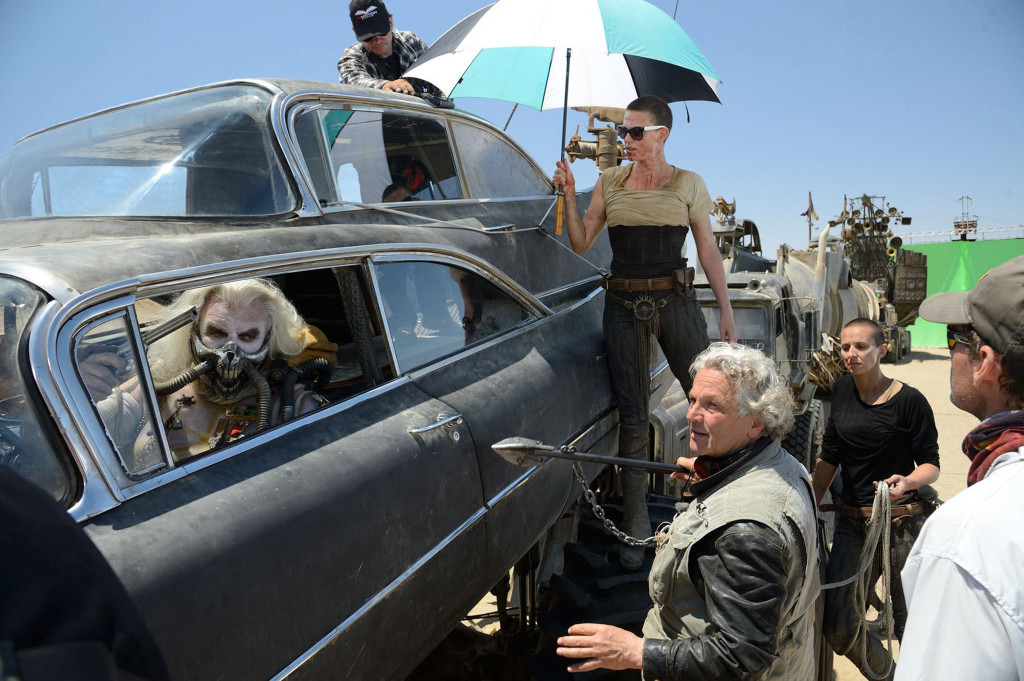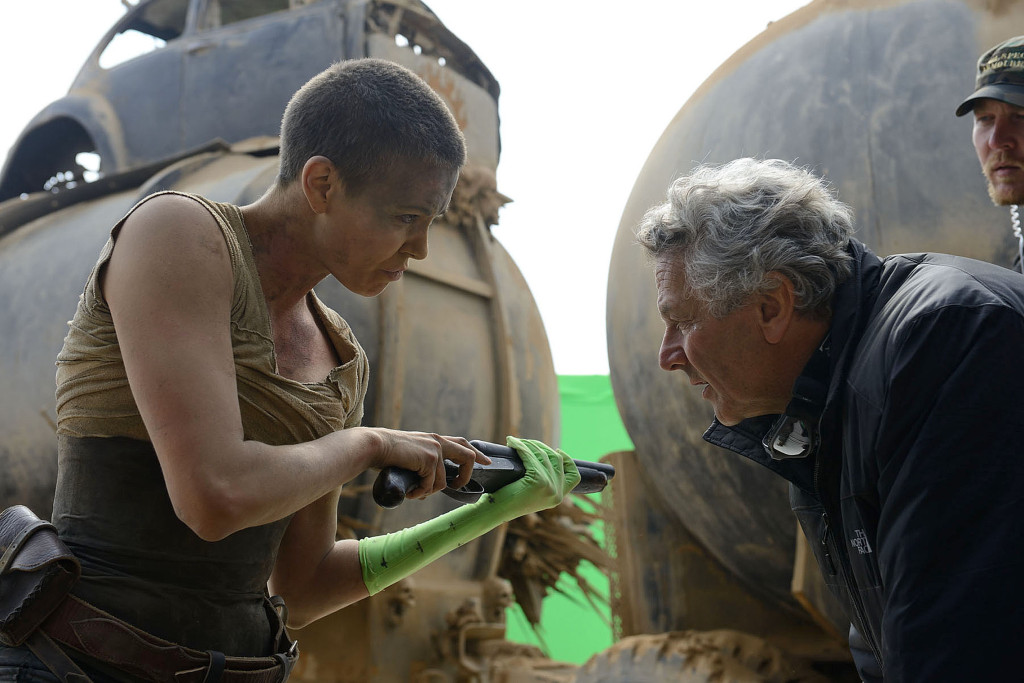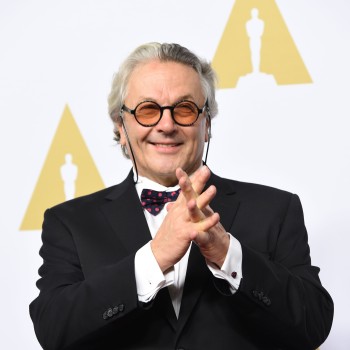Families love George Miller’s animated musical “Happy Feet,” and of course his talking-pig epic “Babe: Pig In The City.” But he’s most celebrated for creating what many consider the greatest action movies ever made: the four “Mad Max” films.
The latest installment, “Mad Max: Fury Road” is up for 10 Oscars — including Best Picture and Best Director. It continues the tale of Max, a tortured ex-cop who roams a post-apocalyptic world, almost accidentally helping good people fight tyrants… and also getting into insane car chases.
This time around Max’s job is to aid a female hero, Furiosa, who is smuggling five wives away from the clutches of the warlord Immortan Joe. Joe pursues with his army of hot rods.
When Rico spoke to George, he started by asking about the filmmaker’s inspiration for the first “Mad Max,” which, in 1979, basically created the dystopian action movie genre. He made it while moonlighting as a medical doctor.

George Miller: Well, it’s interesting. There’s usually a lot of forces that find their way into a story. I know I was definitely interested in action movies; and doing it, not where there’s the talking bits of the movie and then there’s the action bits, but integrating it. That was number one.
Rico Gagliano: The story’s happening while the chase is happening, in a way.
George Miller: Yeah. And number two… growing up in remote, rural Australia, there was a lot of death by autocide. Just people dying on the road. And then, working as a doctor, years later, in a large city hospital, I saw that even more. Somehow that got to me.
Rico Gagliano: Dealing with people with road injuries?
George Miller: Yeah. And I thought, “What would it be like for a cop?” I just wondered what that would do to somebody.
Plus, it was such a low budget. We couldn’t afford to block off city streets in the middle of city. So with all of that, I put in, at the opening of the movie, I said, “A few years from now.” As if it were some dystopian society, a failed society.
Rico Gagliano: So, at first, you made it a post-apocalyptic world just so that you could shoot empty streets and get away with it. People wouldn’t question it.
George Miller: Yeah. I mean, that’s how low the budget was. But I realized that, unwittingly, Max became a kind of archetype that is recognized in all cultures around the world. So, in Japan, he was seen as a samurai, a lone samurai. And, you know, the French picked up that it was basically a Western on wheels, and so on.
But by the time “Road Warrior” [aka “Mad Max 2”] came along, it was much more conscious and it was much more deliberately about an oil crisis. Also, it was much more deliberately the notion of the hero myth, Max the reluctant hero.

Rico Gagliano: I’m guessing, actually, when you made the first “Mad Max,” you didn’t conceive of it as a series.
George Miller: No.
Rico Gagliano: What keeps drawing you back to these characters in this post-apocalyptic world?
George Miller: I think probably the most seductive things about getting pulled into these stories is the notion that they are allegories. In the same way that I think the American Western is basically allegorical — fables, morality tales, and so on.
What’s really interesting is you can draw on virtually all of human history across all cultures and see how the same things tend to recur in our modern day. We got as much of that into “Mad Max: Fury Road” [as we could]: the way tyrants control all the major resources at the expense of the many; people being commodified… in “Mad Max: Fury Road,” everyone except the Immortan Joe wears his logo on their back.
Rico Gagliano: Actually, in this one — speaking of using these myths to talk about important modern-day issues — feminism really comes front and center. The plot is literally about a woman trying to free other women from a patriarch, this warlord. Why was that so foremost on your mind this time around?
George Miller: Well, it wasn’t the primary thing at the get-go. The initial idea was to do virtually a continuous chase. And in this case, the thing that was to be in conflict was human: five wives who are the breeders in the story. Initially, it was seven wives, but we couldn’t fit them all into the cabin of a war rig, so it became five wives!

Rico Gagliano: Yeah, you have to fit them all in a Mac truck, basically.
George Miller: Yeah. And of course, they needed a road warrior, and it couldn’t be male because that’s a different story. So it was a female road warrior.
Rico Gagliano: But why… you’re saying you wanted the things that people were fighting over to be human. Why did you want that to be the case, and why did they specifically have to be women? In “The Road Warrior,” people are fighting over gasoline.
George Miller: Because, again, it had to be very elemental. And I thought, “Well, if it’s human, then it’s not a dispassionate thing.” In a wasteland, you need someone who’s apparently valuable, in a world where people aren’t necessarily very valuable at all…
Rico Gagliano: So, the fact that these women are fertile makes them valuable, horribly.
George Miller: … Yeah, because very few people are. And the Immortan Joe needs a successor, an heir. Which is something that always went on through history with various kings. That’s a very, very common theme.
Rico Gagliano: So, this came purely from the need for narrative? This wasn’t maybe inspired by something in your life or something happening in the world in general?
George Miller: Well, it’s inevitable that you’re observing the world and what’s in your life. I mean, I grew up in a very male culture, a rural culture. I had no sisters. I had brothers, went to all-boys schools.
But subsequently in life, I have at least three wonderful women in my life: my wife, Margaret, who is the editor of the movie; my mother, the kind of matriarch of the family; and a daughter. They’re all magnificent, self-contained, very, very strong women. So, I’ve almost gone to that side. It’s just naturally how my life evolved.
But it’s also that we notice that in the zeitgeist. I remember one day, listening to the radio down in Australia, and Eve Ensler, the playwright — she wrote “The Vagina Monologues” — and also is a great advocate in the Republic of Congo, helping women who’ve been brutalized and destroyed by all the stuff that’s going on there.
She has amazing programs where they take these women and basically teach them to become leaders of their world. I heard her talking about this on the radio, and I thought, “This is exactly what ‘Fury Road’ is about!”
Rico Gagliano: Speaking of strong female characters, in 1987, you directed the comedy, “The Witches of Eastwick.” A bunch of ladies beating the devil. I’m sensing a theme here. You’ve described the making of that movie as pretty much a nightmare, but the saving grace was working with Jack Nicholson, who starred in it. You have said, “He taught me more about life than anyone else.” How so? What did he teach you?
George Miller: Well, one was just purely about work, but it also applies to life, as well. It’s about the creative process. Which is tremendous rigor: that you really figure out, as passionately as possible, all the things you’re struggling with to get, say, a particular story told, or a particular performance. So, endless conversations and so on… But then, in the moment of performance, abandoning yourself. You let everything go.
And the two — even though paradoxical — is a very, very interesting balance. The best analogy is sport, and I think that’s why Jack was so into the Lakers and so on. You think of the great skill sets of sportsmen. They drill, and they work, and they really hone their talent to the highest, optimum degree. But now they’re in the middle of a game, and they can’t think about it. They can’t think about, “Oh, what did I drill?” They’re playing purely out of instinct.
That balance between the discipline, and surrendering yourself to the instinct. That was one big thing.
Rico Gagliano: I’ve heard he advised you, also, to always seem a little crazy. Is that right?
George Miller: Well,
he said, “George, I think there’s a tendency here for people to mistake politeness with weakness.”And he said, “You’ve got to make them think you’re a little crazy.”
Rico Gagliano: How does that manifest itself?
George Miller: Well, it’s kind of a long story, but for instance in an early meeting, I said, “Where can we trim the budget?” This was for “Witches of Eastwick.”
And at this meeting I said, “You know, I don’t use a trailer because I’m always on the set, or I’m with the actors in their trailer.” In Australia, we don’t have big trailers, anyway. Now, that would seem logical; you could save money. But what they read it as, was that I was negotiable on absolutely everything. So, if I needed 150 extras, only 75 would turn up.
I remember when I couldn’t get anybody to listen over a certain problem, and we were heading for a costly mistake, I remember not turning up to set one day. Suddenly, everyone’s calling me, “What’s wrong? What’s wrong?” I said, “Look, there’s a problem I’ve been talking about for three weeks, and no one’s paid any attention. This is the problem.”
They certainly paid attention. And of course, here I was saying, “Oh, OK, the more I behave badly, the more I’m rewarded!”
Rico Gagliano: Last question: when I look at your resume, “eclectic” isn’t strong enough of a word. You’ve made Oscar-nominated dramas like “Lorenzo’s Oil,” the “Mad Max” action films, animated movies for kids. What kind of film haven’t you done that you would like to do?
George Miller: Oh, I hadn’t thought about it. You know, I always wanted to do animation because growing up as a kid, animation had such a big influence. I’m not a dancer or musician, but I always wanted to make a musical, and “Happy Feet” is a musical of a kind…
Rico Gagliano: You said that “Ben Hur” is one of your favorite action movies. Maybe we’re going to see a George Miller-directed Roman epic with a chariot race?
George Miller: Well, in a way, you know, “Fury Road” is almost an ancient Greek chariot race. But yeah!


